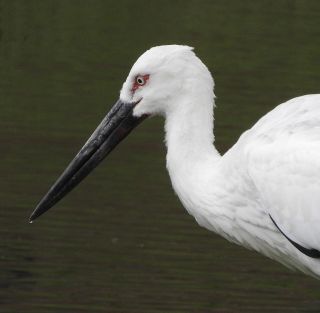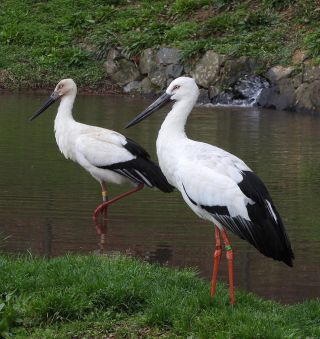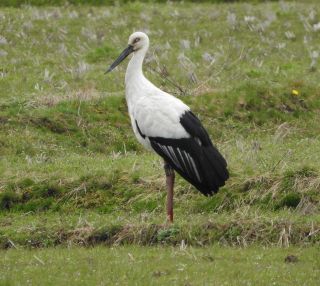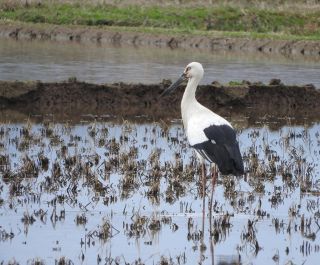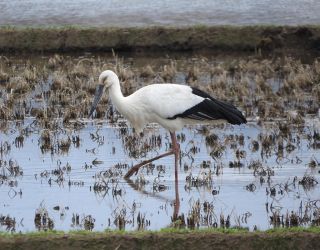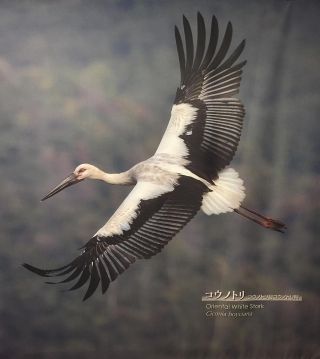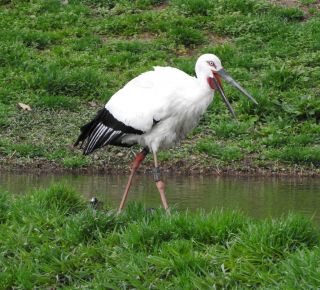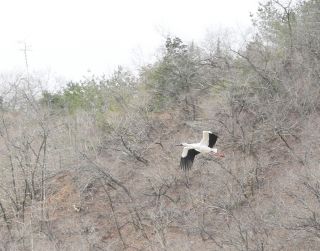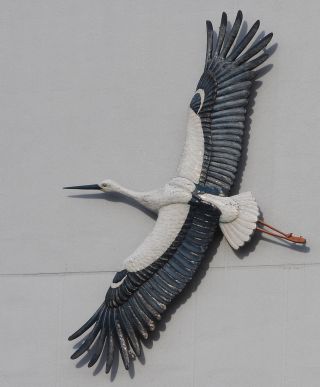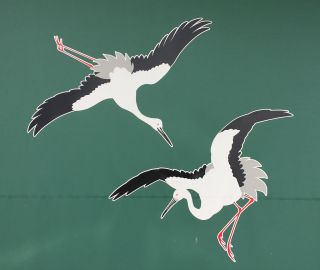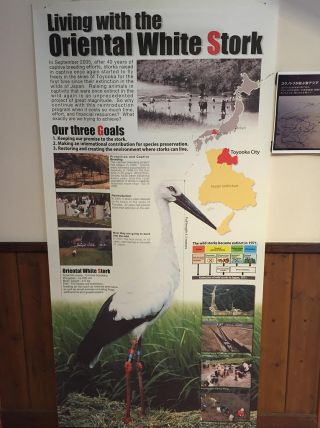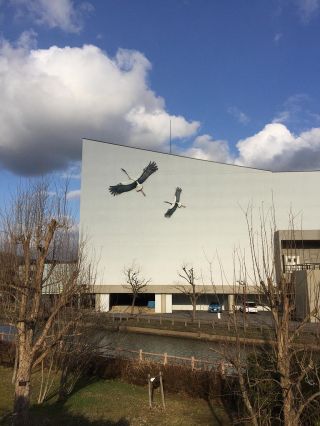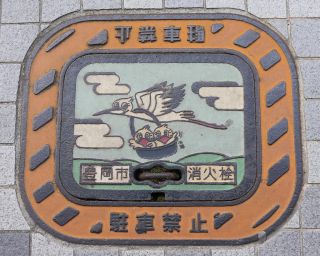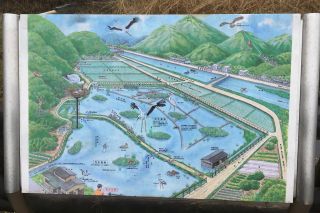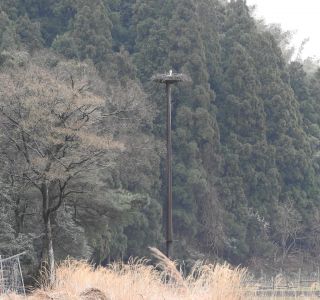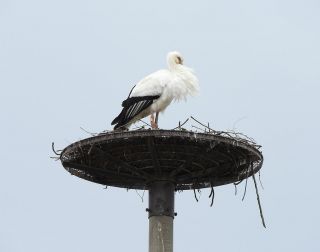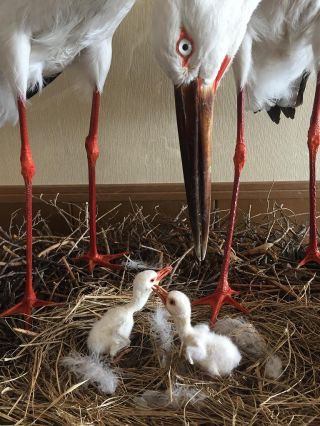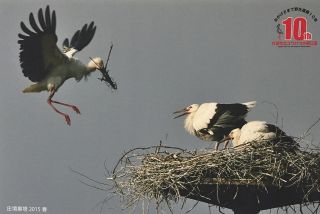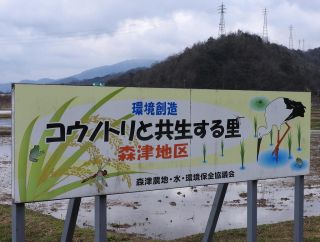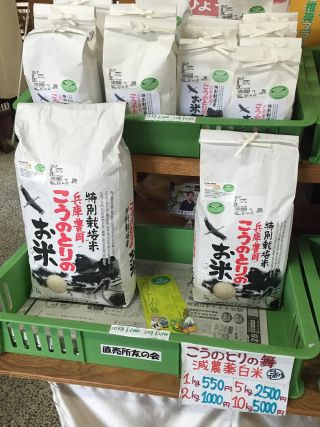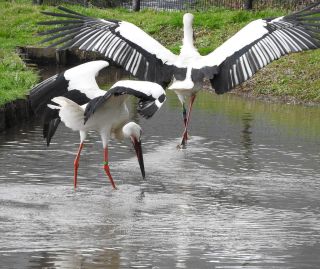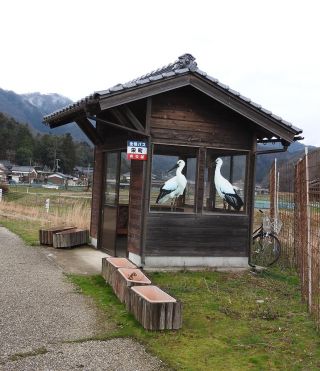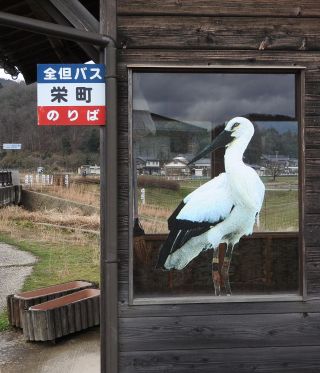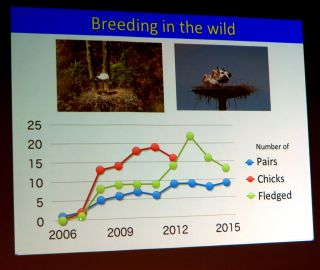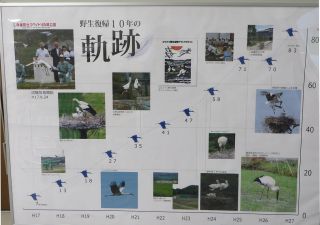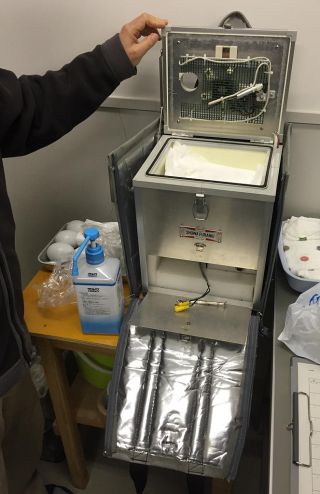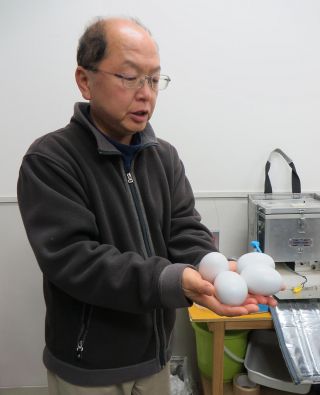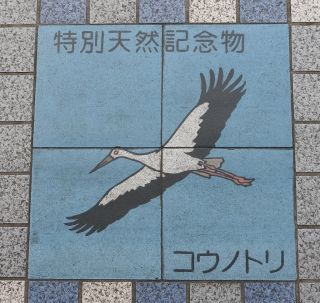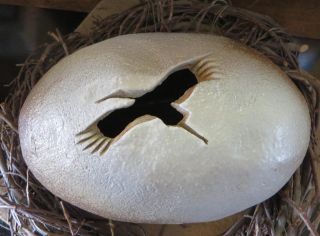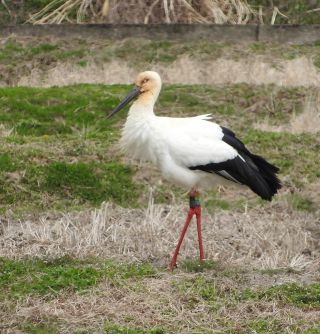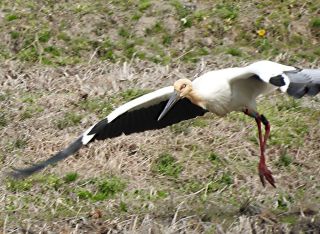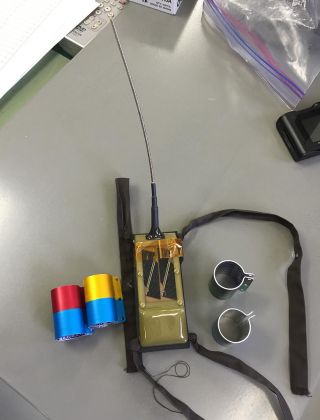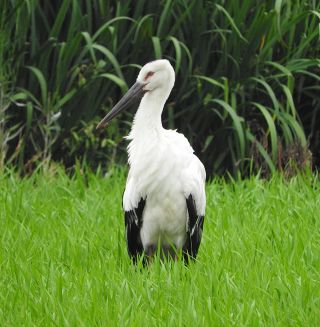Oriental Stork Ciconia boyciana © Mark Brazil
Oriental Storks Making a Come Back in Japan
By Mark Brazil | May 31, 2016
Each year I am reminded of the ceaseless change that sums up life as yet one more friend fades into oblivion. Predeceasing human friends leave behind one facet of loneliness, but the losses of familiar elements of the natural world tear at the tapestry of being, leaving gaping holes in the broader matrix, in the backdrop to our human lives, creating a loneliness of an entirely different order. We lose human friends as individuals, yet however emotional that is for us our own species continues marching forwards un-phased at an ever-increasing pace. In contrast, we lose aspects of the natural world on the scale of global events and whole species, creating gaps in our living world.
So many of these gaps go unnoticed by the public. Such gaps are only noticed by those finely tuned to certain aspects of the world. How many of us have noticed the dwindling visibility of the Milky Way? Once mythologised by cultures around the globe this luminous pathway across the sky has fallen victim to the luminous fog of global light pollution. How many of us have witnessed the dramatic decline in the range and population of the Bengal Tiger? Closer to home, how many of us have witnessed directly the losses to Japan’s coral reefs, to her coastal wetlands, and to the myriad species that occupy those habitats? How many of us have witnessed personally the catastrophic decline in the delightful Yellow-breasted Bunting?
In the early 1980s, when the Yellow-breasted Bunting was still widespread and common in the wetlands and damp grasslands of Hokkaido, I described it to a friend as like chocolate and custard – bright yellow and chestnut – each singing male providing a bright, colourful spot on a damp, foggy early summer’s day, which came with a delightfully cheery song that filled the air. Every place where I once heard them has now fallen silent. Evidence suggests that they have all been…. eaten. Yes, eaten, they were caught originally on the wintering grounds of the northeast Asian population in millions in southern China. Now the Hokkaido breeding population, the one I knew best, has gone.
In recent years I have witnessed the decline of so many summer visitors to Hokkaido: Brown-headed Thrush once abundant are now few; Chestnut-eared Buntings are fading; various grasshopper warblers are far fewer; and the Siberian Rubythroat, once even more common and widespread than the Yellow-breasted Bunting at its peak, and ranging from montane uplands to coastal lowlands, is fast disappearing, in fact already mostly gone from its old haunts.
From the back the Siberian Rubythroat is a drab brown bird, but when it turns to face you its bold face markings and its brilliantly bright ruby throat patch is gorgeous; then there is its bubbling, warbling refrain, carrying the melancholy of foggy early summer days, and the excitement of avian sexual enticement. I miss their sounds, their calls, their songs, as I miss those of other creatures that were once common here in Japan.
With so much loss, it is a treat to know that there are dedicated conservationists working tirelessly to bring back certain species that were once thought doomed. Here in Japan, to balance the sadness of the losses of Yellow-breasted Buntings and Siberian Rubythroats and their many peers, several creative projects are engaged in the process of avian recovery. Most notably, enormous efforts have been made to bring back from near extinction the Short-tailed Albatross (Diomedea albatrus), the Red-crowned Crane (Grus japonensis), Blakiston’s Fish Owl (Bubo blakistoni), the Crested Ibis (Nipponia nippon), and the Oriental Stork (Ciconia boyciana). These projects have been undertaken with varying, but mostly considerable, success (see previous Wild Watch articles Japan’s efforts bring back ‘extinct’ species | Jun 7, 2014 and Back where they belong | Aug 16, 2009 about the resurrection of the Crested Ibis).
I am so fortunate to have witnessed each of those species and to have met a number of the dedicated researchers, field workers and laboratory workers engaged in projects to conserve them. I have marvelled at the graceful and effortless flight of Short-tailed Albatross around their breeding colony on Torishima, witnessed the hatching of Red-crowned Crane eggs in the wild, helped ring Blakiston’s Fish Owl nestlings, seen the first nest built by a Crested Ibis on Sado after the first releases of captive bred birds there, and I have encountered a number of Oriental Storks over recent decades.
Each time I encountered a stork it was as an accidental visitor from the dwindling continental population, as the wild breeding population in Japan was extinct. The species’ native range includes south-easternmost Russia, along the border of Russia and China along the Amur River basin, along the Ussuri River, and the lower reaches of the Wuyuerhe River in Heilongjiang Province, China. Migrants from those breeding grounds mainly winter in southern China and along the lower Yangtze River basin, but very small numbers also winter on the Korean Peninsula and in Japan, or occur there as spring overshoot migrants that have missed their way back, and it was such birds that I had encountered. From memory, I have logged individual migrant storks in west Hokkaido, in south-western Kyushu, and even once in Okinawa and I have had near misses twice on Amami-Oshima.
The Oriental Stork has undergone a rapid decline over the last century and today it is considered endangered, because of its very small population which is thought to be somewhere in the region of 1,000-2,500 individuals. Threats to it include wetland reclamation for agriculture, deforestation, and overfishing, making its future rather bleak. In Japan the last birds bred in the wild in the 1960s and since then it has been considered extinct here. For that reason, each of the sightings I have made has seemed extraordinarily lucky.
Historically, the forested hills of Japan supported forests containing mature pine trees with spreading branches, that were strong and broad, and ideal for nesting storks, especially when they were in close proximity to narrow valleys with wet rice fields, or coastal wetlands, where food for the birds was plentiful. The loss of those mature pines, and their replacement with plantations of cypress and cedar, whose branches offer no support for nesting storks, combined with changes in farming practices doomed the population of the Oriental Stork that once bred in Japan. By the 1960s the storks were considered one more victim of Japan’s headlong rush to recover and reconstruct after the war. They no longer bred here.
Amazingly, the Oriental Stork was once considered conspecific with the smaller, red-billed White Stork of Europe and Africa, though it differs in so many ways. The Oriental Stork stands an imposing 110–150 cm tall and is only marginally shorter than the stately Red-crowned Crane. The stork weighs 2.8–5.9 kg and has a wingspan of 2.22 m, again only slightly smaller than the 2.2-2.5 m span of the crane. It is easily distinguished from its more widespread western cousin, by a combination of factors, its size and black bill being the most obvious. At close range, the bare red skin surrounding the eye, and the white iris are two more key features, while when walking and in flight the Oriental Stork’s black and white “piano-key” wing pattern is dramatically distinctive.
The Oriental Stork’s scientific name, Ciconia boyciana, is what is known as eponymous, that is it is derived from a person’s name. I am a fan of eponymous names – they serve to remind us of the history of a subject. In this case, the scientific name of this black-billed stork of eastern Asia is derived from the name of a British architect and engineer, Robert Henry Boyce (1834-1909), who for a spell was the Principal Surveyor of HM Diplomatic and Consular Buildings in China. Though quite why he is commemorated in this way remains something of a mystery.
For more than a decade I have been hearing about grand plans to resurrect the lost Oriental Stork population of Japan, but a busy schedule had prevented me from investigating further, until earlier this year. An opportunity to visit Hyogo Prefecture with my wife Mayumi and our friend and colleague Chieko Sakihana (Japan’s top interpreter/guide) on our way back from an invitational visit to Saga Prefecture, provided me at long last with a chance to encounter Oriental Stork’s in situ and through the eyes of some of the figures involved in this remarkable success story.
Hyogo Prefecture has truly taken this bird under its wing. Now the prefectural bird, the Oriental Stork greets visitors at so many turns. The gateway to stork conservation in Japan is Toyooka. If one flies in to the area, via the Tajima Konotori Airport no less, there is art there as a welcome, in the form of a stork reaching for the skies. If one drives into Toyooka, then it is hard to miss the Civic Hall (Shimin Kaikan) with storks flying across its façade, or the welcoming signs emblazoned with storks across the road. Among my favourites though are: the appearance of storks on the city’s colourful manhole covers (Japanese manhole cover art is an entire subject in itself, and not one really for Wild Watch); and the tiled depictions along one of the shopping streets. Stork art is just about everywhere in Toyooka, from edible souvenir packages of cookies, to shopping bags, shop fronts, coffee shops and even the streets in front of them.
Visiting Toyooka for the first time this year I was charmed by the conspicuous efforts being made by the city to bring a focus to bear on the endangered storks of the area. Mr Yousuke Kawasumi, of Toyooka City Government, was our kindly host in Toyooka and it was he who took time out of his busy schedule to introduce me to several important figures in the area. We chatted about the storks as we drove out of town and along the Maruyama River valley towards the NPO managed wetland of Hachigoro no Toshima Shicchi. There the enthusiastic Mr Setsuo Satake greeted us and told us the background story of the loss of the storks from Japan, and then described how a come back is being staged thanks to the provision of suitable habitat and the construction of nesting platforms.
In Europe, where storks have long been considered good omens and the deliverers of new-born babies, they have been encouraged to nest on chimney tops, towers, church spires, electricity poles, nesting platforms and the like. Taking a leaf from that book, Toyooka City has realized the goal of installing a range of sturdy poles in suitable spots along the river valley, each pole topped with a platform suitable for storks to nest upon. Each pole provides the support that a pine tree would have done in generations past. Looking out from the visitor centre I could see across a small but diverse wetland area; eventually I noticed a tall pole set back a little way from the wetland and close in near the woodland edge. It was then that I realized that the television screen was not showing a video but that it was actually a live monitor showing a stork on the nest on the top of the pole I could see! We were to see several more occupied pole nests along the valley that day, but not before Satake-san had introduced me, via a muddy hands-on experience, to the vibrant life in the streams and wet fields on which the storks depend. Preserving a suitable food supply for the storks has been a crucial element of the recovery programme.
A key element in the success of the Oriental Stork conservation project has been involving the local agricultural community. It was the success of intensifying and modernizing farming during the 1950s and 1960s in order to increase yields so as to feed a growing population that led to the loss of diversity in the rice field wetlands, and it was that which contributed to the decline in the wild stork population. Having persuaded local farmers that there is now an added value to farming in a stork friendly way, conservationists in the area have had a chance to undo some of the detrimental aspects of previous decades.
Pine forests that once supported nesting storks, on the hills above the river valley were felled before and during World War II. Agricultural chemicals, that came increasingly in to favour as Japan’s economy improved, not only reduced the populations of the small rice field organisms on which the storks fed, but also accumulated within their bodies, and that toxicity caused them to become less viable. These factors, combined with reducing the period over which water was retained in the rice fields, and modifications to field irrigation and drainage that prevented fish, frogs and other aquatic creatures from coming and going between streams and fields, led to the decline, then the loss of the storks from the area. Just as Toki (Crested Ibis) Rice has proven popular on Sado Island, so too in Toyooka Konotori Rice is proving popular in Hyogo Prefecture. Farmers have now realized that there are sufficient members of the public willing to pay a premium for rice grown in a stork-friendly way and more organically, and in response to that demand the area of land being farmed in such a way is increasing steadily.
Researchers might consider that Oriental Storks are carnivorous and polyphagous, but to lay folk that means that they have an extremely varied diet and eat almost anything that moves or that wanders into their proximity. During spring storks gorge on frogs and fish in and around the rice fields, then as the weather warms and dragonflies emerge they take to snatching dragonflies from the air too. The storks consume native species and introduced species with abandon and are important predators of the introduced American Red Crayfish, which causes damage to the rice crops. During May and June, when rice planting has finished, the storks enjoy the bounty of abundant creatures in the wet fields. During their early summer nesting season they also consume snakes, small mammals, earthworms and even small turtles. As the rice crop grows ever taller the storks move away from the fields where they now find it difficult to locate prey and instead they forage along the banks between the rice fields and in the irrigation ditches and streams. As late summer begins to fade and the rice is being harvested the storks forage in and around the fields again. Now they feast on grasshoppers and locusts as long as they remain abundant, but take more snakes as the insect populations decline in autumn. Soon the hard times of winter return and the storks find it more and more difficult to locate prey. They prefer foraging in shallow water, which is why it is so important that rice fields remain flooded through the winter, or are flooded early well before the rice planting season. Like many large birds they may experience a seasonal pattern in weight, losing weight over winter, but regaining it again in spring. Ensuring that sufficient suitable habitat is available for them throughout the year is vital to their survival.
Toyooka City, the Hyogo prefectural government, and the Japan Agricultural Cooperative (JA) have combined forces and since 2003 they have jointly encouraged local farmers to adopt stork-friendly farming methods in order to support the released storks with that necessary habitat. This is the restoration arm of the overall plan to bring back storks to the prefecture and to Japan. The aims of this project have included using minimal agricultural chemicals, such as pesticides, and increasing the diversity and populations of organisms inhabiting the rice fields through field and irrigation management. The scheme requires that farmers: reduce their pesticide use by at least 75 per cent, preferably entirely; use no fertilizers; soak rice seeds in hot water to sterilize them against rice-borne diseases; flood their rice fields and retain water in the rice fields for longer periods so as to allow various species of frogs and dragonflies sufficient time to develop from the egg stage to the adult stage; flood rice fields in wintertime or for at least one month prior to rice planting in order to encourage the sludge worms that help inhibit weed growth.
In the first eight years of the project, the area of land being used to grow rice in a stork-friendly manner was increased from zero to over 200 hectares. Of course using minimal agricultural chemicals means that farmers lose more of their yield (c25%) compared with conventional methods, but the higher prices paid for rice grown with less, or no, chemical input offsets that loss and, as there is a trend among consumers to seek out safer foods, the advantages seem likely to continue.
Farmers currently receive subsidies from the local government to encourage them to keep their fields flooded during winter (¥7,000 per 1,000 square metres) and to create stork-friendly biotopes out of unused fields (¥27,000 per 1,000 square metres). In addition to providing more suitable habitat for storks and the prey species that they feed on, the knock-on return from the overall project has been producing value-added rice, and a local eco-tourism industry valued already in 2009 at more than ¥1 billion.
You too can visit the area and see wild storks for yourselves, and contribute to the success of this project by encouraging the local community to keep up their impressive work. Of course the success of this project hasn’t come about just through encouraging farmers, there is a whole different element to this story, and to learn about that I visited Kounotori no Sato.
Konotori no Sato (as it is also spelled), is the “factory floor” of the captive breeding and release programme. While restoration, providing suitable habitat for released birds, and nest pole construction, providing suitable nesting sites, have been going on “outside”, other aspects are being tackled “inside”.
Dr Kazuaki Naito, an associate professor of Hyogo University, and staff of Konotori no Sato kindly filled in much of the back-story for me, told me about his research into the stork’s biology and ecology and showed me around the centre’s impressive facilities. Part of the restricted area of the facility is dedicated to cages for the breeding pairs. We only saw them in passing, so as not to disturb them, as there were incubating females in each cage, but how amazing that this captive breeding is now an annual event; how incredible that there is a restricted area filled with breeding birds!
The first experiments to breed Oriental Storks in captivity in Japan date back to 1965, as the very last wild birds were being lost from the country. More recently, it was with help from Russia that the modern captive breeding project was begun and success finally came in 1989 with the first born in captivity in Japan. Success followed success and by 2005 there were more than 100 in captivity with many breeding pairs. It was in 2005 that Toyooka City launched a pilot release scheme, returning captive bred birds into the wild for the first time in decades. The first birds were released in September of that year. Being helped along by Crown Prince Naruhito was a guarantee of making the national media, and it was news of this event that had me itching to visit the area for more than ten years. Over the course of those ten years the numbers of birds released has steadily grown, and by the ten-year anniversary more than 80 storks had been released into the wild. The released birds were slow to begin breeding, but that is natural among large long-lived birds, they don’t rush into pairing and productivity, theirs is the long slow approach to replacing themselves. The first released pair nested in the wild in 2007 and since 2008 there have been 5-10 pairs nesting annually fledging as many as 20 chicks in some years. As with many projects of this kind there are good years and bad years, successes, hurdles, and surprises. One of those surprises was that this project that began locally in Hyogo Prefecture soon spread beyond the borders of that prefecture and in fact very soon became international. Not only have visitors come from Korea, China and Russia to learn about the project, but released storks and their offspring have made visits to many parts of Japan from northernmost Honshu to the Nansei Shoto islands, and even as far afield as the Korean Peninsula.
It is typical of young birds to wander in their first years, and entrenched in their genetic make-up is a migratory urge, so the wandering storks are becoming wonderful ambassadors to other prefectures, some of which also wish to participate in the restoration programme. As you can imagine, transporting live storks to other conservation and captive breeding facilities around the country is a very expensive business involving not only special secure transport, but also veterinary care and considerable paperwork to move a protected endangered species. Mr Minoru Funakoshi, a lively and dedicated staff member at Konotori no Sato kindly showed me the release box used for the very first release used by the crown prince, and the elegant solution to saving the expense of moving birds around the country. That solution was to scale down the in-house incubators that were being used to incubate stork eggs as the facility, and to develop a fully portable incubator that could be used to carry up to four eggs at a time. In this way it has been possible to support captive breeding in other parts of the country more quickly and, it is hoped this will ultimately lead to a more rapid spread and increase in the wild population. Perhaps soon storks flying over the rice field landscape of Japan will be commonplace once more.
Saying my farewells to Dr Naito, Mr Funakoshi, Mr Satake and Mr Kawasumi I thought that my contact with the reintroduction programme for storks might be over for some considerable time, unless that is I was to return to Hyogo Prefecture with eager stork watchers. However, on that occasion, Mayumi and I travelled from Hyogo to Shiga to meet up with our friend Angus Macindoe and birdwatch the area of northeastern Lake Biwa, and there we bumped into further evidence of the success of the stork programme. An Oriental Stork, dubbed J0073, was in the area and was being watched over by a local stork lover, and a local photographer who kindly led us to the area it frequented. We were able to visit it twice and enjoy watching it forage across the fields.
Tracking storks on the ground is not easy. Despite their size they can quickly disappear into a deep ditch or stream, but there are eyes in the sky. Many of the released individuals carry numbered leg bands, plus a combination of up to four coloured bands allowing observers to identify them even at a distance. Once they are out of sight to binoculars and telescope there is only one thing that gives away their location and that is the solar powered backpack transmitter that sends out a signal that can be picked up by satellite. We may not know where all of our Siberian Rubythroats are disappearing, but thanks to advanced technology we can track individual storks and find out exactly where they go, how long they stay there and even with whom they meet up along the way. The backpack transmitter being flat is easily lost among the dense plumage of the stork’s back, so that the only tell tale sign is the flexible antenna that protrudes above the feathers. Even that can be hard to spot.
On the penultimate day of a more than three-week journey through Japan, I received news of another wandering Oriental Stork, this time in Saitama Prefecture. Being with guests who had never seen one in the wild before, it seemed an obvious distraction on what became a round about route that took us from Narita first to the Tone River, then Inbanuma, to watch various avian species, then into Saitama Prefecture to look for the stork – on our way back to Narita Airport. Finding the stork proved easier than negotiating the Sunday afternoon traffic and the narrow streets of Shin-misato, and in the elation of finding it I failed to notice something that showed up immediately in photographs – it too was carrying a tracking harness. Someone, somewhere, knows exactly the history of that bird’s movements. He goes by the tag J0127 and the name Kizuna. The people in the neighbourhood seemed thrilled to have the bird in their local rice fields and to have a chance to see it through our telescope.
Lets hope that the success of the reintroduction programme will spread and that more and more people around the country will have the opportunity to encounter wild Oriental Storks in their neighbourhood.
Outro
If you have read this far, then you may enjoy my previous articles, including recent offerings such as: Daijugarami: Stepping Stone to the Arctic (April 2016); Whale Watching Japan-style: Zamami (March 2016), Snow Monkeys & Cranes of Japan: Spectacular Winter Wildlife (February 2016), Amami Night Safari (January 2016), Life at the Water’s Edge (December 2015), and The Bird that Saved Me from Death (November 2015).
These Wild Watch articles, and many more, can be found on this website, and on our Facebook page (please do visit and hit the “Like” button).
Author, naturalist, lecturer and guide, Dr Mark Brazil has written his Wild Watch column continuously since April 1982. All Wild Watch articles dating back to 1999 are archived here for your reading pleasure.
A collection of Mark’s essays The Nature of Japan and two handy pocket guides The Common and Iconic Birds of Japan and The Common and Iconic Mammals of Japan have been published and are also available from www.japannatureguides.com

